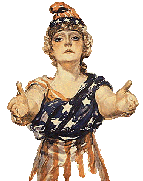

Exploring our past to sort out myth from reality
Share this Page on
Facebook or Twitter

These are the voyages of the TimeShip Anachron.
Our Mission: To boldly explore the past, dispelling
mythinformation and mythconceptions
of American History along the way.
 Visit us on Facebook
Visit us on Facebook
Meet MythAmerica SNAPSHOT
Uncle Sam’s Girlfriend
Almost every American, and many of the people in the rest of the world, have long been familiar with Uncle Sam. He’s been around “representing” the United States of America since the early 1800s, although his most famous gig was as a poster boy in 1917:

Sam is what is known as a “national personification.” A national personification is an anthropomorphism [attributing real human characteristics to something non-
Sam himself is not one of those “majestic” personifications of a Roman god, of course. He’s a down-
But he’s long been quite the ladies’ man! And there were plenty majestic ladies to court. Here are “Marianne” (personification of France),“Mother Russia,” and Brittania from a 1914 Russian poster.

Here’s Sam, steppin’ out with Britannia.

And here he is, being tempted by a thoroughly Modern Marianne of the 1930s with a bottle of wine hidden up her sleeve! (This is an advertisement from a French magazine for the popular BYRRH wine of the time.)

However, although Sam has had flirtations with other national-

Columbia is a historical and poetic name used for the United States of America and is also the name of its female personification. It has inspired the names of many persons, places, objects, institutions, and companies; i.e., Columbia University, the District of Columbia (the national capital), and the Columbia River. Columbia was largely displaced as the female symbol of the U.S. by the Statue of Liberty circa 1920. [Wiki: Columbia (name)]
As mentioned above, Columbia disappeared from most “pop culture” settings such as Fourth of July posters and parades, replaced by Sam and the Statue of Liberty by the time of mychildhood in the 1950s. But if we would have grown up in the late 1800s and early 1900s, we would have seen her image all over the place, including on posters during the WW1 era just like Sam.



She always wore the goddess-

The Phrygian cap is a soft conical cap with the top pulled forward, associated in antiquity with the inhabitants of Phrygia, a region of central Anatolia [part of the area of modern Turkey]. In the western provinces of the Roman Empire it came to signify freedom and the pursuit of liberty, perhaps through a confusion with the pileus, the felt cap of manumitted (emancipated) slaves of ancient Rome. Accordingly, the Phrygian cap is sometimes called a liberty cap; in artistic representations it signifies freedom and the pursuit of liberty.
The first time I noticed the cap on the head of Columbia in paintings and such, I thought it very odd. I think I know why now.

Yes, the Smufs all wear Phrygian caps!
Sam and Columbia were long used, together and separately, as poignant symbols to tug at the heartstrings of Americans regarding issues of Patriotism, American cultural values, and American customs.

And they were also frequently portrayed in political cartoons, to emphasize partisan political points of view. Such as in this 1898 cartoon from Puck magazine.

Or this one from 1918.

Although these two mythical characters are somewhat fluid in what how they are portrayed in metaphor, in general Sam tends to represent the government of the United States, and Columbia the “nation” of people.
Sam and Columbia have thus often been used to perpetuate some of the mythperceptions of American history.
Columbia is THE “MythAmerica.” We will be running across her and her boyfriend Sam often in articles on this website.